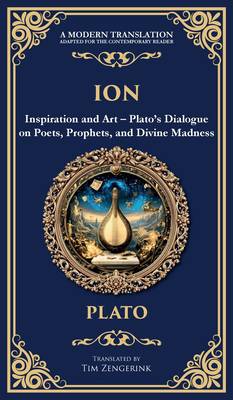The Stone of Heraclea and the Rings of Inspiration

The Stone of Heraclea and the Rings of Inspiration
Plato’s short dialogue Ion is often read too quickly and without much interest, for it has not shown well in the literature of philosophers. At first glance it seems a minor exchange between Socrates and a professional reciter of Homer, Ion. Yet hidden within it is a wondrous image of inspiration in Western thought: the Stone of Heraclea, the magnet that draws iron rings and passes its force along a chain.
In the dialogue, Socrates uses this simple picture to show Ion that his gift is not a matter of skill or knowledge, but of being taken hold of by something greater—much greater. It is the Divine Muse that inspires Homer, and it is Homer who seizes Ion, and Ion who seizes his audience. Each is a ring in the chain, suspended by the same invisible power.

In the East, such a current would be called transmission — the radiance of a master, the darshan of a rishi. In the Greek world it was the Muse. In our own time we may still recognize it in those moments when we are moved beyond ourselves, carried by a song, a word, or even a silence.
The meditation that follows turns on this image — the Stone of Heraclea and the rings of inspiration — and on the lesson Socrates draws from it: that the source of creation is not in us, but moves through us.
***
The Stone of Heraclea and the Rings of Inspiration
“The gift which you possess… is a divinity moving you, like that contained in the stone which Euripides calls a magnet, but which is commonly known as the stone of Heraclea.” — Plato, Ion
In Ion, Socrates turns to a curious natural marvel: the stone of Heraclea. This was the name the Greeks gave to a magnet, known in antiquity as a mysterious stone with the power to draw iron. Heraclea, a city on the Black Sea, was famous for deposits of this ore, and so the stone took its name. To the Greeks, its invisible power was a wonder: how could a lifeless stone move iron without touching it?
Socrates takes this everyday image and makes it into a teaching. He says to Ion, the rhapsode devoted to Homer:
“This stone not only attracts iron rings, but also imparts to them a similar power of attracting other rings; and sometimes you may see a number of pieces of iron and rings suspended from one another so as to form quite a long chain. And all of them derive their power of suspension from the original stone.”
Here, in plain words, is a whole philosophy of inspiration. The Muse is the original magnet. From her hangs the poet, the first ring. From the poet hangs the rhapsode, the second ring. From the rhapsode hangs the audience, the third. All are suspended. All are held by the unseen pull of the Muse.
Ion’s Confession
Socrates presses Ion: if you are a man of art, why only Homer? Why not Hesiod, Archilochus, or Pindar? Ion admits that he grows tired at the mention of other poets but comes alive with Homer. That is the mark, Socrates says, of possession, not knowledge. If it were knowledge, it would apply everywhere. If it were art, it would be transferable, something that could be taught to schoolchildren. But Ion is seized only by Homer.
And Ion himself confesses it: “When I speak of horrors, my hair stands on end and my heart throbs. At tales of pity, my eyes are filled with tears.” He is not in his right mind when he performs. He trembles, he weeps, he is carried outside and beyond himself, to where he knows not where.
Socrates answers with the image of the stone again:
“Do you know that the spectator is the last of the rings which, as I am saying, receive the power of the original magnet from one another? The rhapsode like yourself and the actor are intermediate links, and the poet himself is the first of them. Through all these the God sways the souls of men in any direction which he pleases, and makes one man hang down from another.”
The Chain of Inspiration
The force of the metaphor is hard to miss. None of the rings stand on their own. They are suspended, each held by the power of the first stone. And each ring, once charged, holds another. The whole chain trembles with the same force.
Socrates expands the metaphor into a vision: “a vast chain of dancers and masters and under-masters of choruses.” The creative current does not move in a straight line only, but in circles, in choruses, in patterns of call and response.
-
The poet is the master, seized directly by the Muse.
-
The rhapsode is the under-master, interpreting the master.
-
The chorus of listeners are the dancers, moving to rhythms they did not compose.
What we call culture, tradition, or art is in this view a great choreography of transmission — rings linked to rings, dancers following dancers, all suspended from the divine magnet.
This is not the product of knowledge or skill. It is the play of attraction, the power of being taken hold of. The poet does not compose by his own art. The rhapsode does not move the audience by his own craft. Each is seized. Each is carried. Each is a ring in the chain.
East and West
In the Greek world this was called inspiration, possession by the Muse. In the East it would be called transmission, the overflow of Shakti, darshan, the power of the rishi or master. In both traditions the pattern is the same: the disciple does not generate the force but receives it. In receiving it, he becomes the channel through which it may touch others.
The magnet’s pull was a mystery to the Greeks, as transmission remains a mystery to us in our scientific and doubtful world. But the experience is undeniable. Go to a movie: Ion’s trembling is your fearful vision during a suspense scene; your tears, and those of the audience, are part of the same chain of attraction that passes from one to another. This is how transmission shows itself in today’s world.
The Lesson of the Stone
Ion resists. He wants to say his eloquence is knowledge. But his own body, his own words, give him away. He is seized, he is held — not master. Socrates has shown it to him with the simplest of examples: magnetism, a stone that draws iron without touching it.
The lesson is simple. The source is not in us. The Muse speaks. We are suspended. The poet, the rhapsode, the audience — all are rings in the chain of inspiration, hanging from the power of the Stone of Heraclea.
Plato’s Ion holds this image: the stone of Heraclea, and the rings of poet, rhapsode, and audience suspended from the unseen magnet of the Muse. We have seen Ion confess that his voice trembles, that his heart pounds, that he is carried outside himself when Homer moves him. We have seen Socrates point again and again: this is not art, not skill; this is the play of a power beyond the self.
Today
If Socrates feels distant, let me pull you closer with something modern, something alive: Elizabeth Gilbert’s TED Talk, “Your Elusive Creative Genius.”
In her talk, Gilbert shares how, in old days, people did not believe creativity came from inside the individual alone. They believed it came from something outside — an attendant spirit, a muse, a genius — that visited humans. She says this belief can relieve us of terrible pressure: the pressure to be creativity, when maybe our task is simply to receive it, to open ourselves to it, to let the force move through us.
In that sense, Socrates and Gilbert meet across the centuries. They both point to something simple and true: creation is not ownership. Creation is being taken hold of. The poet (or writer, or artist, or you) is a ring in the chain. Sometimes it carries us beyond ourselves — that is the work of the Muse, the genius, the magnetic force.
Remember, when you are moved — by a feeling, an impulse, a melody, a poem, a word, a stranger’s kindness — pause. Don’t let it go by unnoticed. Recognize, re-member, the feeling-force. Name it if you wish. Know in the moment that it is not wholly yours, yet it moves through you, and for a moment, is given to you.
What do you do with it? Let that force inform you. Let it wash into your work or your being, not as something to be possessed but as something to be offered, if you feel it worthwhile. If not, simply recognize there is something greater than you making your world unfold.
Your elusive creative genius
“In ancient Greece and ancient Rome people did not happen to believe that creativity came from human beings. People believed that creativity was this divine attendant spirit that came to human beings from some distant and unknowable source, for distant and unknowable reasons.
The Greeks famously called these divine attendant spirits of creativity “daemons.” Socrates, famously, believed that he had a daemon who spoke wisdom to him from afar.” – Elizabeth Gilbert
***
